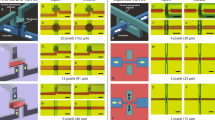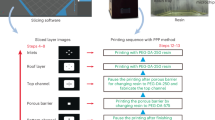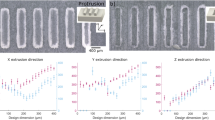Abstract
We describe a technique for fabricating microfluidic devices with complex multilayer architectures using a laser printer, a CO2 laser cutter, an office laminator and common overhead transparencies as a printable substrate via a laser print, cut and laminate (PCL) methodology. The printer toner serves three functions: (i) it defines the microfluidic architecture, which is printed on the overhead transparencies; (ii) it acts as the adhesive agent for the bonding of multiple transparency layers; and (iii) it provides, in its unmodified state, printable, hydrophobic 'valves' for fluidic flow control. By using common graphics software, e.g., CorelDRAW or AutoCAD, the protocol produces microfluidic devices with a design-to-device time of ∼40 min. Devices of any shape can be generated for an array of multistep assays, with colorimetric detection of molecular species ranging from small molecules to proteins. Channels with varying depths can be formed using multiple transparency layers in which a CO2 laser is used to remove the polyester from the channel sections of the internal layers. The simplicity of the protocol, availability of the equipment and substrate and cost-effective nature of the process make microfluidic devices available to those who might benefit most from expedited, microscale chemistry.
This is a preview of subscription content, access via your institution
Access options
Subscribe to this journal
Receive 12 print issues and online access
$259.00 per year
only $21.58 per issue
Buy this article
- Purchase on Springer Link
- Instant access to full article PDF
Prices may be subject to local taxes which are calculated during checkout










Similar content being viewed by others
References
Manz, A., Graber, N. & Widmer, H.M. Miniaturized total chemical analysis systems: a novel concept for chemical sensing. Sens. Actuat. B1 1, 244–248 (1990).
Duffy, D.C., Gillis, H.L., Lin, J., Sheppard, N.F. & Kellogg, G.J. Microfabricated centrifugal microfluidic systems: characterization and multiple enzymatic assays. Anal. Chem. 71, 4669–4678 (1999).
Grumann, M. et al. Sensitivity enhancement for colorimetric glucose assays on whole blood by on-chip beam-guidance. Biomed. Microdevices 8, 209–214 (2006).
Vella, S.J. et al. Measuring markers of liver function using a micropatterned paper device designed for blood from a fingerstick. Anal. Chem. 84, 2883–2891 (2012).
Park, J., Sunkara, V., Kim, T.-H., Hwang, H. & Cho, Y.-K. Lab-on-a-disc for fully integrated multiplex immunoassays. Anal. Chem. 84, 2133–2140 (2012).
Lee, B.S. et al. Fully integrated lab-on-a-disc for simultaneous analysis of biochemistry and immunoassay from whole blood. Lab Chip 11, 1170–1178 (2011).
Lai, S. et al. Design of a compact disk-like microfluidic platform for enzyme-linked immunosorbent assay. Anal. Chem. 76, 1832–1837 (2004).
Lagally, E.T., Emrich, C.A. & Mathies, R.A. Fully integrated PCR-capillary electrophoresis microsystem for DNA analysis. Lab Chip 1, 102–107 (2001).
Heller, M.J. DNA microarray technology: devices, systems, and applications. Annu. Rev. Biomed. Eng. 4, 129–153 (2002).
Zhang, Y. & Ozdemir, P. Microfluidic DNA amplification—a review. Anal. Chim. Acta. 638, 115–125 (2009).
Focke, M. et al. Microstructuring of polymer films for sensitive genotyping by real-time PCR on a centrifugal microfluidic platform. Lap Chip 10, 2519–2526 (2010).
Yu, H. et al. A simple, disposable microfluidic device for rapid protein concentration and purification via direct printing. Lab Chip 8, 1496–1501.
Zhu, Z., Lu, J.J. & Liu, S. Protein separation by capillary gel electrophoresis: a review. Anal. Chim. Acta. 709, 21–31 (2012).
Gao, J., Yin, X.-F. & Fang, Z.-L. Integration of single cell injection, cell lysis, separation and detection of intracellular constituents on a microfluidic chip. Lab Chip 4, 47–52 (2004).
Lindström, S. & Andersson-Svahn, H. Overview of single-cell analyses: microdevices and applications. Lab Chip 10, 3363–3372 (2010).
Le Roux, D. et al. Integrated sample-in-answer-out microfluidic chip for rapid human identification by STR analysis. Lab Chip 14, 4415–4425 (2014).
LaRue, B.L., Moore, A., King, J.L., Marshall, P.L. & Budowle, B. An evaluation of the RapidHIT® system for reliably genotyping reference samples. F 13, 104–111 (2014).
Tan, E. et al. Fully integrated, fully automated generation of short tandem repeat profiles. Invest. Genet. 4:16, 1–15 (2013).
Chin, C.D. et al. Microfluidics-based diagnostics of infectious diseases in the developing world. Nat. Med. 17, 1015–1019 (2011).
Fiorini, G.S. & Chiu, D.T. Disposable microfluidic devices: fabrication, function, and application. Biotechniques 38, 429–446 (2005).
Moreau, W.M. Semiconductor Lithography: Principles and Materials (Plenum, 1998).
Xia, Y. & Whitesides, G.M. Soft lithography. Angew. Chem. Int. Ed. 37, 550–575 (1998).
Whitesides, G.M., Ostuni, E., Takayama, S., Jiang, X. & Ingber, D.E. Soft lithography in biology and biochemistry. Annu. Rev. Biomed. Eng. 3, 335–373 (2001).
McDonald, J.C. et al. Fabrication of microfluidic systems in poly(dimethylsiloxane). Electrophoresis 21, 27–40 (2000).
McDonald, J.C. & Whitesides, G.M. Poly(dimethylsiloxane) as a material for fabricating microfluidic devices. Acc. Chem. Res. 35, 491–499 (2002).
Duffy, D.C., Schueller, O.J.A., Brittain, S.T. & Whitesides, G.M. Rapid prototyping of microfluidic switches in poly(dimethyl siloxane) and their actuation by electro-osmotic flow. J. Micromech. Microeng. 9, 211–217 (1999).
Unger, M.A., Chou, H.-P., Thorsen, T., Scherer, A. & Quake, S.R. Monolithic microfabricated valves and pumps by multilayer soft lithography. Science 288, 113–116 (2000).
Thorsen, T., Maerkl, S.J. & Quake, S.R. Microfluidic large-scale integration. Science 298, 580–584 (2002).
Phanneuf, C. et al. Sensitive, microliter PCR with consensus degenerate primers for Epstein-Barr virus amplification. Biomed. Microdevices 15, 221–231 (2013).
Ouyang, Y. et al. Rapid patterning of 'tunable' hydrophobic valves on disposable microchips by laser printer lithography. Lab Chip 13, 1762–1771 (2013).
Lounsbury, J.L. & Landers, J.P. Ultrafast amplification of DNA on plastic microdevices for forensic STR analysis. J. Forensic Sci. 58, 866–874 (2013).
Sollier, E., Murray, C., Maoddi, P. & Di Carlo, D. Rapid prototyping polymers for microfluidic devices and high pressure injections. Lab Chip 11, 3752–3765 (2011).
Hoople, G.D. et al. Comparison of microscale rapid prototyping techniques. J. Micro- and Nano-Manufact. 2, 034502-1–034502-6 (2014).
Bartholomeusz, D.A., Boutté, R.W. & Andrade, J.D. Xurography: rapid prototyping of microstructures using a cutting plotter. J. Microelectromech. Syst. 14, 1364–1374 (2005).
Duarte, G.R.M., Price, C.W., Augustine, B.H., Carrilho, E. & Landers, J.P. Dynamic solid phase DNA extraction and PCR amplification in polyester-toner based microchip. Anal. Chem. 83, 5182–5189 (2011).
Duarte, G.R.M. et al. Disposable polyester-toner electrophoresis microchips for DNA analysis. Analyst 137, 2692–2698 (2012).
Leslie, D.C. et al. New detection modality for label-free quantification of DNA in biological samples via superparamagnetic bead aggregation. J. Am. Chem. Soc. 134, 5689–5696 (2012).
do Lago, C.L., Silva, H.D.T., Neves, C.A., Brito-Neto, J.G.A. & Silva, J.A.F. A dry lamination process for production of microfluidic devices based on the lamination of laser-printed polyester films. Anal. Chem. 75, 3853–3858 (2003).
Madou, M. et al. Lab on a CD. Annu. Rev. Biomed. Eng. 8, 601–628 (2006).
Tan, A., Rodgers, K., Murrihy, J.P., O'Mathuna, C. & Glennon, J.D. Rapid fabrication of microfluidic devices in poly(dimethylsiloxane) by photocopying. Lab Chip 1, 7–9 (2001).
Arthur D Little Inc. Report to International Business Machines Corporation; investigation of two haloid-Xerox machines as new product opportunities in the office reproducing equipment field, mimeo, (Dec 1, C-61613, 1958).
Li, J. et al. Label-free method for cell counting in crude biological samples via paramagnetic bead aggregation. Anal. Chem. 85, 11233–11239 (2013).
Acknowledgements
We gratefully acknowledge funding from the US National Institutes of Health grant number 5R01EB011591-04. We also acknowledge invaluable discussions with D. Haverstick and J. Li.
Author information
Authors and Affiliations
Contributions
B.L.T., S.T.K. and Y.O. designed the chips. Y.O. and G.R.M.D. were critical in the development of the early protocol. E.C. helped develop the concept. B.L.T. and Y.O. conducted the experiments. B.L.T., Y.O. and J.P.L. analyzed the data. B.L.T. and J.P.L. wrote the paper.
Corresponding author
Supplementary information
Supplementary Text and Figures
Supplementary Methods (PDF 209 kb)
Rights and permissions
About this article
Cite this article
Thompson, B., Ouyang, Y., Duarte, G. et al. Inexpensive, rapid prototyping of microfluidic devices using overhead transparencies and a laser print, cut and laminate fabrication method. Nat Protoc 10, 875–886 (2015). https://doi.org/10.1038/nprot.2015.051
Published:
Issue Date:
DOI: https://doi.org/10.1038/nprot.2015.051
This article is cited by
-
Machining water through laser cutting of nanoparticle-encased water pancakes
Nature Communications (2023)
-
Point-of-use printed nitrate sensor with desalination units
Microchimica Acta (2022)
-
Cost-effective and rapid prototyping of PMMA microfluidic device via polymer-assisted bonding
Microfluidics and Nanofluidics (2021)
-
Micropatterning of planar metal electrodes by vacuum filling microfluidic channel geometries
Scientific Reports (2018)
-
Endothelial Cell Culture Under Perfusion On A Polyester-Toner Microfluidic Device
Scientific Reports (2017)
Comments
By submitting a comment you agree to abide by our Terms and Community Guidelines. If you find something abusive or that does not comply with our terms or guidelines please flag it as inappropriate.



